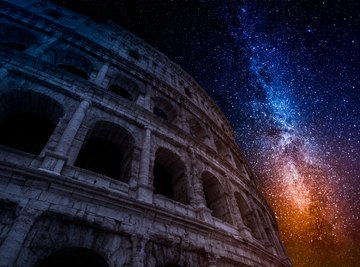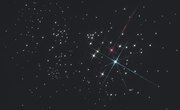
Long before the ancient peoples of the Earth utilized the stars and plants to figure out when to plant and harvest their crops, they named the constellations – most of which are still in use today – and told stories about the heroes and gods, animals and mythological creatures represented in the stars. Besides the entertainment factor, these stories about the stars helped ancient storytellers teach both young and old, preserve their cultures and instill moral values into the tribe’s citizens.
TL;DR (Too Long; Didn't Read)
An ancient tribe in Mali, Africa -- the Dogon People -- claims knowledge of the heavens learned from a people who descended to Earth from the stars. As the tale goes, these ancient astronauts, the Nommos, came from the planet Sirius near Orion's Belt and visited the Dogon people hundreds of years ago. The Dogon people told two French astronomers in 1930 that Sirius really consists of two stars, as well as telling them the Earth was round and surrounded by space. In 1970, astronomers confirmed the existence of a companion star to Sirius, naming them Sirius A and B.
Oral Traditions
The poet Hesiod, around 700 BC, was the first to offer up to the Greeks a mythology of the cosmos. The story, using the stars, shared the secret of the Universe’s journey from its primitive void of nothingness to its big bang existence by detailing a genealogy of elements, goddesses, gods and mythical creatures. Centuries later writers and artists built upon this cosmological mythology by creating heroes, such as Perseus, who killed the monster Cetus to rescue the princess Andromeda. Perseus, Cetus and Andromeda can still be found in the night sky.
Circle, Stone or Timber Calendars
As early as 5,000 years ago, some of the first astronomers observed changes in the sun and moon. They noticed patterns in the sun's rising and setting and in the shape and position of the moon on any given evening. They often built shrines or henges that told them of key astrological moments such as the winter and summer solstices or the spring and fall equinoxes. This helped them to know when to plant crops after frosts and when to harvest them before winter descended. Henges exist all over the United Kingdom, the most famous being Stonehenge. Henges could be no more than a circular ditch, a circular mound or consist of stones and timbers to define the circle.
Ancient Navigators
Ancient sailors used the stars to help guide them while they were at sea. The Phoenicians looked to the sun’s movement across the heavens to tell them their direction. Early astronomers realized that some constellations, such as the Big Dipper, were only seen in the northern part of the sky. The location of the North Star -- Polaris -- helped travelers figure the direction they needed to head in to reach their destination. As part of the Ursus Minor constellation, the lesser bear, Polaris sits above the northern planetary pole without moving too much, making it an excellent navigational tool.
Predicting the Future
The creation of astrological signs came from some of Earth's earliest astronomers. In ancient Babylon, astronomers kept track of the paths and movements of the planets. Most ancient civilizations believed that observing the movement of the planets could help to predict the future and determine the course an individual's life would take.
References
About the Author
Julie Ackendorf has been a writer since 2007. She has contributed health, legal and parenting articles for various online publications. Ackendorf graduated from SUNY Empire State College, earning a Bachelor of Science in community and human services with a minor in child and adolescent development.
